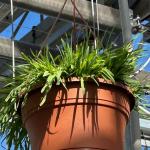During greenhouse visits this week, aphids were observed on some crops.
As temperatures start to increase, aphid populations can increase dramatically if control measures are not taken. Aphids are common pests of spring greenhouse crops, but they can easily escape detection early in the season when numbers are low. Scout for aphids regularly by checking new growth for shiny honeydew, white cast skins, and/or the aphids themselves. Look under the leaves, growing terminals, behind flowers, and check the stems. Regular monitoring and scouting programs are needed to detect aphids early before populations explode. This is very important, especially for hanging baskets which unfortunately can be more labor intensive to scout.
There are many aphid species, but green peach aphids are found most readily in greenhouses. Melon aphids (also called cotton aphids) and foxglove aphids are also common. Foxglove aphids especially thrive in cool conditions (50-60⁰ F). Aphids have a wide host range.
Aphids can be effectively managed using biological controls. If used early in the crop cycle, biological control can be very effective, and are most effective if released preventively before aphids become a problem. It is important to correctly identify the aphids before releasing biological control agents; specific agents should be matched to the kind of aphid and the environmental conditions. For example, Aphidius colemani is best used to control small aphids such as green peach and melon aphids. For larger aphids such as foxglove and potato aphids, Aphidius ervi is the most effective. Contact your supplier for more information on matching the aphid species to the appropriate biological control.
Adding a banker plant system can help lower the cost of biological control of aphids and increase the effectiveness of a biological control program. Banker plants support an alternative insect species which the biocontrol agents feed on but do not pose a threat to the crops being produced.
For an aphid banker plant system, a cereal aphid (Rhopalosiphum padi) that does not attack most greenhouse bedding plants, is raised on cereal plants such as barley, wheat or oats. Aphidius colemani [a parasite commonly used to manage green peach aphid (Myzus persicae), as well as cotton or melon aphid (Aphis gossypii] is released onto the banker plants when the population of the cereal aphid is high enough to sustain the parasite. For larger aphids such as the foxglove aphid, use aphid banker plants to support the predatory midge, Aphidoletes aphidimyza, which is able to attack the larger aphids. Banker plant systems should be started at least 4-6 weeks before pests are expected. You can also purchase aphid banker systems from producers. Contact your biological control supplier.
Aphids can be difficult to manage with insecticides. With that said, there are several insecticides labeled for the control of aphids. Consult the latest edition of New York and New England Greenhouse Floriculture Management Guidelines (https://www.negreenhouse.org/pest-guides.html). Systemic insecticides such as Mainspring (IRAC 28), Kontos (IRAC 23), Endeavor (IRAC 9B), and Altus (IRAC 4D) are more effective because aphids ingest large amounts of sap. For contact insecticides, thorough coverage of leaf undersides is needed to achieve good control. Be sure to rotate between different insecticide classes (modes-of-action) to prevent resistance build up.
- Geoffrey Njue, Extension Specialist, UMass Extension Greenhouse Crops and Floriculture Program

